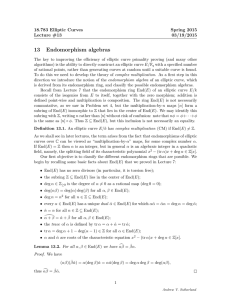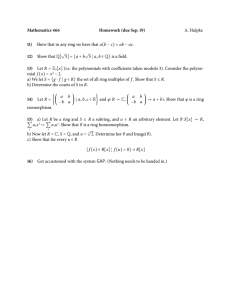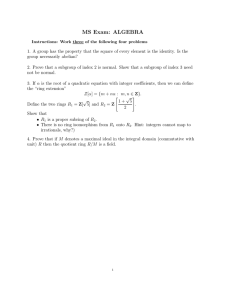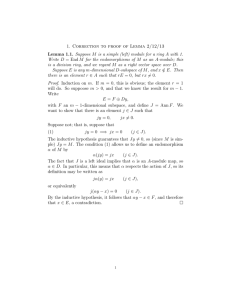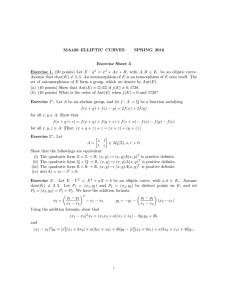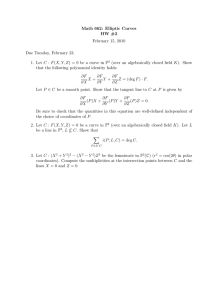13 Endomorphism algebras 18.783 Elliptic Curves Spring 2015
advertisement
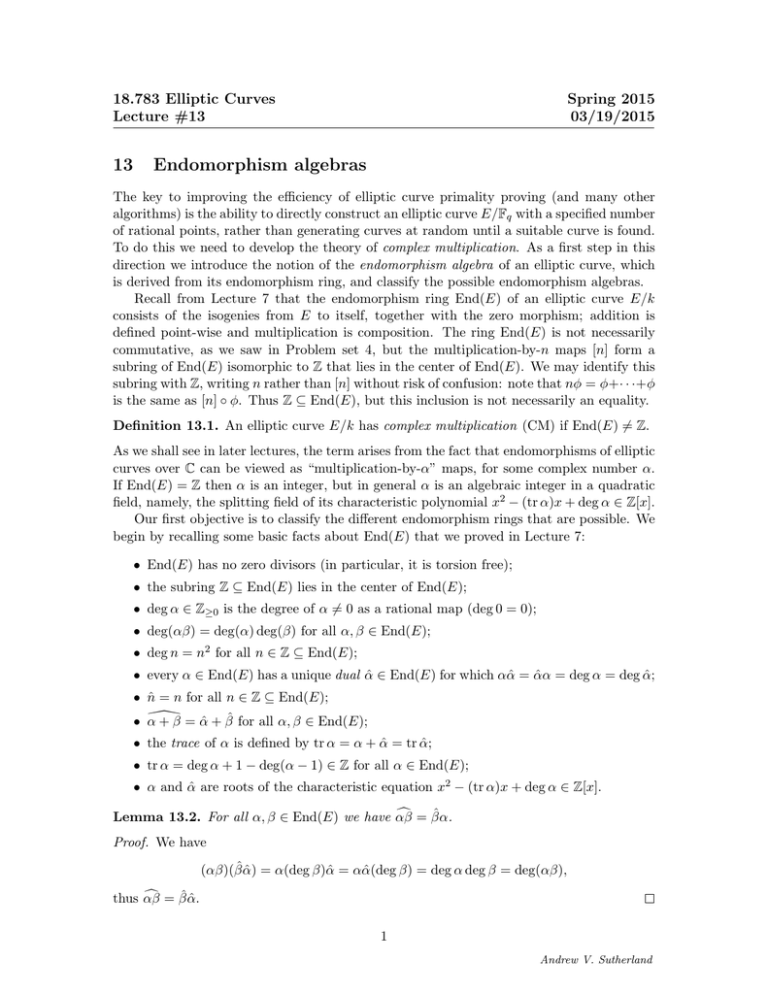
18.783 Elliptic Curves
Lecture #13
13
Spring 2015
03/19/2015
Endomorphism algebras
The key to improving the efficiency of elliptic curve primality proving (and many other
algorithms) is the ability to directly construct an elliptic curve E/Fq with a specified number
of rational points, rather than generating curves at random until a suitable curve is found.
To do this we need to develop the theory of complex multiplication. As a first step in this
direction we introduce the notion of the endomorphism algebra of an elliptic curve, which
is derived from its endomorphism ring, and classify the possible endomorphism algebras.
Recall from Lecture 7 that the endomorphism ring End(E) of an elliptic curve E/k
consists of the isogenies from E to itself, together with the zero morphism; addition is
defined point-wise and multiplication is composition. The ring End(E) is not necessarily
commutative, as we saw in Problem set 4, but the multiplication-by-n maps [n] form a
subring of End(E) isomorphic to Z that lies in the center of End(E). We may identify this
subring with Z, writing n rather than [n] without risk of confusion: note that nφ = φ+· · ·+φ
is the same as [n] ◦ φ. Thus Z ⊆ End(E), but this inclusion is not necessarily an equality.
Definition 13.1. An elliptic curve E/k has complex multiplication (CM) if End(E) 6= Z.
As we shall see in later lectures, the term arises from the fact that endomorphisms of elliptic
curves over C can be viewed as “multiplication-by-α” maps, for some complex number α.
If End(E) = Z then α is an integer, but in general α is an algebraic integer in a quadratic
field, namely, the splitting field of its characteristic polynomial x2 − (tr α)x + deg α ∈ Z[x].
Our first objective is to classify the different endomorphism rings that are possible. We
begin by recalling some basic facts about End(E) that we proved in Lecture 7:
• End(E) has no zero divisors (in particular, it is torsion free);
• the subring Z ⊆ End(E) lies in the center of End(E);
• deg α ∈ Z≥0 is the degree of α 6= 0 as a rational map (deg 0 = 0);
• deg(αβ) = deg(α) deg(β) for all α, β ∈ End(E);
• deg n = n2 for all n ∈ Z ⊆ End(E);
• every α ∈ End(E) has a unique dual α̂ ∈ End(E) for which αα̂ = α̂α = deg α = deg α̂;
• n̂ = n for all n ∈ Z ⊆ End(E);
\
• α
+ β = α̂ + βˆ for all α, β ∈ End(E);
• the trace of α is defined by tr α = α + α̂ = tr α̂;
• tr α = deg α + 1 − deg(α − 1) ∈ Z for all α ∈ End(E);
• α and α̂ are roots of the characteristic equation x2 − (tr α)x + deg α ∈ Z[x].
c = βα.
ˆ
Lemma 13.2. For all α, β ∈ End(E) we have αβ
Proof. We have
ˆ = α(deg β)α̂ = αα̂(deg β) = deg α deg β = deg(αβ),
(αβ)(βα̂)
cβ = βα̂.
ˆ
thus α
1
Andrew V. Sutherland
ˆ α̂
ˆ = α and 1̂ = 1, the lemma implies that the
\
Together with the facts α
+ β = α̂ + β,
map ϕ 7→ ϕ̂ is an involution of End(E).
Definition 13.3. An anti-homomorphism ϕ : R → S of rings is a homomorphism of their
additive groups for which ϕ(1R ) = 1S and ϕ(αβ) = ϕ(β)ϕ(α) for all α, β ∈ R. An involution
(also called an anti-involution) is an anti-homomorphism ϕ : R → R that is its own inverse,
meaning that ϕ ◦ ϕ is the identity map.
Note that an involution is an isomorphism when the ring is commutative, but not in
general (the restriction to the center is always an isomorphism).
13.1
The endomorphism algebra of an elliptic curve
The additive group of End(E), like all abelian groups, is a Z-module. Recall that if R is a
commutative ring, an R-module M is an (additively written) abelian group that admits a
scalar multiplication by R compatible with its structure as an abelian group. This means
that for all α, β ∈ M and r, s ∈ R:
(r + s)α = rα + sα,
rα + rβ = r(α + β),
r(sα) = (rs)α,
1α = α.
(one can check these imply 0α = 0 and (−1)α = −α).
The ring End(E) is not only a Z-module. Like all rings, it has a multiplication that
is compatible with its structure as a Z-module, and this makes it a Z-algebra. For any
commutative ring R, an (associative unital) R-algebra A is a (not necessarily commutative)
ring equipped with a ring homomorphism R → A that maps R into the center of A.1 In
our situation the map Z → End(E) sending n to [n] is injective and we simply view Z as a
subring of End(E). When we have a ring A with an involution that is also an R-algebra,
we typically require the involution to fix R in order to view it as an R-algebra involution;
for the involution α 7→ α̂ on our Z-algebra End(E), this is true.
We now want to “upgrade” our Z-algebra End(E) to a Q-algebra (in other words, a Qvector space with a multiplication that is compatible with its structure as a vector space),
To do this we take the tensor product of End(E) with Q.
Definition 13.4. The endomorphism algebra of E is End0 (E) := End(E) ⊗Z Q.
For a commutative ring R, the tensor product A ⊗R B of two R-modules A and B can
be defined as the R-module generated by the formal symbols α ⊗ β with α ∈ A and β ∈ B,
subject to the relations
(α1 + α2 ) ⊗ β = α1 ⊗ β + α2 ⊗ β,
α ⊗ (β1 + β2 ) = α ⊗ β1 + α ⊗ β2 ,
rα ⊗ β = α ⊗ rβ,
for α1 , α2 ∈ A, β1 , β2 ∈ B and r ∈ R. The third relation lets us pull out scalars from A
or B and treat them as scalars of A ⊗R B. Notice that the tensor product is not a direct
product (or sum); for example, we always have 0 ⊗ β = α ⊗ 0 = 0, but this is not true in
any non-trivial direct product. Another difference is that the general element of A ⊗R B is
a finite sum of monomial tensors α ⊗ β and cannot necessarily be written as a single α ⊗ β
(but in the special case we are interested in, this is actually true — see Lemma 13.5 below).
1
Here we consider only associative unital algebras; one can define a more general notion of an R-algebra
that is not necessarily a ring (Lie algebras, for example).
2
When A and B are R-algebras, not just R-modules, we give the tensor product A ⊗R B
the structure of an R-algebra by defining
(α1 ⊗ β1 )(α2 ⊗ β2 ) = α1 α2 ⊗ β1 β2 .
P
P
This allows us to compute ( i αi ⊗ βi )( j αj ⊗ βj ) via the distributive law (which holds by
decree); the multiplicative identity is 1A ⊗ 1B . The R-algebras A and B can be canonically
mapped into A ⊗R B via α 7→ α ⊗ 1B and β 7→ 1A ⊗ β. These maps need not be injective
(indeed,A ⊗R B may be the zero ring even when A and B are not, consider Z/2Z ⊗Z Z/3Z,
for example), but in the case we are interested in they are.
If you have never seen tensor products before this might seem like a lot of abstraction
to swallow, but fear not! We are actually only interested in what is essentially the simplest
non-trivial example of a tensor product of algebras: we are tensoring two Z-algebras, one
of which is the fraction field of Z. The net effect is that we are simply extending our ring
of scalars Z to its fraction field Q. This actually simplifies makes things simpler.
With this in mind, we will simply write elements α ⊗ r of End(E) ⊗Z Q as rα. The only
difference between rα with r ∈ Q and nα with n ∈ Z is that the former is not necessarily
an endomorphism, it is a formal element of the endomorphism algebra End0 (E). But if
we multiply rα by the denominator of r we will get an element of End(E) (viewed as a
subring of End0 (E) via the natural embedding). To justify this notation, we should verify
that every element of End0 (E) = End(E) ⊗Z Q can actually be written in the form α ⊗ r.
Lemma 13.5. Let R be an integral domain with fraction field B, and let A be an R-algebra.
Every element of A ⊗R B can be written in the form a ⊗ b with a ∈ A and b ∈ B.
Proof. It suffices to show that α1 ⊗ β1 + α2 ⊗ β2 can be written as α3 ⊗ β3 . Let β1 = r1 /s2
and β2 = r2 /s2 with r1 , r2 , s1 , s2 ∈ R. Then
r1
r2
+ α2 ⊗
s1
s2
r1 s2
r2 s1
= α1 ⊗
+ α2 ⊗
s1 s2
s1 s2
1
1
= r1 s2 α1 ⊗
+ r2 s1 α2 ⊗
s1 s2
s1 s2
1
= (r1 s2 α1 + r2 s1 α2 ) ⊗
,
s1 s2
α1 ⊗ β 1 + α2 ⊗ β 2 = α1 ⊗
so we may take α3 = r1 s2 α1 + r2 s1 α2 and β3 = 1/(s1 s2 ).
We also note that Q lies in the center of End0 (E) (since Q is commutative and Z lies in
the center of End(E)), and we note that the canonical homomorphisms End(E) → End0 (E)
and Q → End0 (E) are injective because End(E) and Q are torsion free Z-algebras (but note
that the images of these homomorphisms intersect non-trivially), thus we may regard both Q
and End(E) as subrings of End0 (E) that intersect in Z.
13.2
The Rosati involution and the reduced norm and trace
We now extend the involution α 7→ α̂ on End(E) to End0 (E) by defining rα
c = rα̂ for all
ˆ
r ∈ Q. This implies that r̂ = r for all r ∈ Q (take α = 1), and therefore α̂ = α holds for all
c = βα̂
ˆ and α
\
α ∈ End0 (E). We also have αβ
+ β = α̂ + βˆ for all α, β ∈ End0 (E), since these
3
hold for elements of End(E) and scalars are fixed by α 7→ α̂ and commute. Thus the map
α 7→ α̂ is an involution of the Q-algebra End0 (E), and it is known as the Rosati involution.
The Rosati involution allows us to extend the notions of degree and trace on End(E) to
a norm and a trace defined on all of End0 (E).
Definition 13.6. Let α ∈ End0 (E). The (reduced) norm of α is Nα = αα̂ and the
(reduced) trace of α is Tα = α + α̂.
We now show that Nα and Tα lie in Q, and prove some other facts we will need.
Lemma 13.7. For all α ∈ End0 (E) we have Nα ∈ Q≥0 , with Nα = 0 if and only if α = 0.
We also have Nα̂ = Nα and N(αβ) = NαNβ for all α, β ∈ End0 (E).
Proof. Write α = rφ, with r ∈ Q and φ ∈ End(E). Then Nα = αα̂ = r2 deg φ ≥ 0. If
either r or φ is zero then α = 0 and Nα = 0, and otherwise Nα > 0. For α =
6 0 we have
αNα̂ = αα̂α = (Nα)α = αNα, so α(Nα̂ − Nα) = 0, and multiplying both sides on the left
by α̂ yields Nα̂(Nα̂ − Nα) = 0, so Nα̂ = Nα (since Nα, Nα̂ ∈ Q>0 ). For any α, β ∈ End0 (E),
cβ = αββα̂
ˆ = α(Nβ)α̂ = αα̂Nβ = NαNβ.
N(αβ) = αβα
Corollary 13.8. Every nonzero α ∈ End0 (E) has a multiplicative inverse α−1 .
Proof. Let α ∈ End0 (E) be nonzero. Then Nα 6= 0 and β = α̂/Nα 6= 0, and we have
αβ = αα̂/Nα = 1. Thus every nonzero element of End0 (E) has a right inverse, including β.
So let γ be a right inverse of β. Then βγ = 1 and γ = αβγ = α, so βα = 1. Thus β is also
a left inverse of α and therefore α−1 = β.
The corollary implies that End0 (E) is a division ring, meaning that it satisfies all the
field axioms except possibly commutativity of multiplication. The division ring End0 (E) is
a field if and only if it is commutative.
Lemma 13.9. For all α ∈ End0 (E) we have Tα ∈ Q and Tα̂ = Tα. For any r ∈ Q,
α, β ∈ End0 (E) we have T(α + β) = Tα + Tβ, and T(rα) = rTα.
Proof. We first note that
Tα = α + α̂ = 1 + αα̂ − (1 − α)(1 − α̂) = 1 + Nα − N(1 − α) ∈ Q,
ˆ = α̂ + α = α + α̂ = Tα. We also have
and Tα̂ = α̂ + α̂
T(α + β) = α + β + b(α + β) = α + β + α̂ + βˆ = α + α̂ + β + βˆ = Tα + Tβ.
and
T(rα) = rα + rc
α = rα + α̂r̂ = rα + α̂r = rα + rα̂ = r(α + α̂) = rTα.
Lemma 13.10. For all α ∈ End0 (E), α and α̂ are roots of the characteristic polynomial
x2 − (Tα)x + Nα ∈ Q[x].
Proof. We have
0 = (α − α)(α − α̂) = α2 − α(α + α̂) + αα̂ = α2 − (Tα)α + Nα
and similarly for α̂, since Tα̂ = Tα and Nα̂ = Nα.
4
Corollary 13.11. For any nonzero α ∈ End0 (E), if Tα = 0 then α2 = −Nα < 0. An
element α ∈ End0 (E) is fixed by the Rosati involution if and only if α ∈ Q.
Proof. The first statement follows immediately from α2 − (Tα)α + Nα = 0. For the second,
we have already noted that r̂ = r for r ∈ Q, and if α̂ = α then the discriminant (Tα)2 −4Nα
of x2 − (Tα)x + Nα must be zero, in which case α = (Tα)/2 ∈ Q.
13.3
Quaternion algebras
In order to give a complete classification of the possible endomorphism algebras End0 (E)
that can arise, we need to introduce quaternion algebras.
Definition 13.12. A quaternion algebra over a field k is a k-algebra that has a basis of the
form {1, α, β, αβ}, with α2 , β 2 ∈ k × and αβ = −βα.
Let H be a quaternion algebra over a field k. Then H is a 4-dimensional k-vector space
with basis {1, α, β, αβ}, and we may distinguish the subspace k ⊆ H spanned by 1, which
does not depend on the choice of α and β. The complementary subspace H0 is the space of
pure quaternions. Every x ∈ H has a unique decomposition of the form a + x0 with a ∈ k
and x0 ∈ H0 . The unique x̂ = a − x0 for which x + x̂ = 0 is the conjugate of x.
The map x 7→ x̂ is an involution of the k-algebra H, and we have a reduced trace
Tx := x + x̂ and reduced norm Nx := xx̂, both of which lie in k. It is easy to check that
Tx = Tx̂, Nx = Nx̂ and that the trace is additive and the norm is multiplicative.
Lemma 13.13. A quaternion algebra is a division ring if and only if Nx = 0 implies x = 0.
Proof. Let x be a nonzero element of a quaternion algebra H. Then x̂ 6= 0 (since 0̂ = 0 =
6 x)
−1
−1
−1
If H is a division ring, then x has an inverse x and x Nx = x xx̂ = x̂ 6= 0, so Nx 6= 0.
Conversely, if Nx =
ˆ Nx) = 1 and (x/
ˆ Nx)x = 1, so x has an inverse x/
ˆ Nx, and
6 0 then x(x/
this implies that H is a division ring.
Example 13.14. An example of a quaternion algebra that is a division ring is the ring
of Hamiltonians, which is the R-algebra with basis {1, i, j, ij}, where i2 = j 2 = −1 and
ij = −ji (the product ij is often denoted k).
13.4
Classification theorem for endomorphism algebras
We are now ready to prove our main result, which classifies the possible endomorphism
algebras of an elliptic curve.
Theorem 13.15. Let E/k be an elliptic curve. Then End0 (E) is isomorphic to one of:
(i) the field of rational numbers Q;
(ii) an imaginary quadratic field Q(α) with α2 < 0;
(iii) a quaternion algebra Q(α, β) with α2 , β 2 < 0.
Quaternion algebras over Q (or R) with α2 , β 2 < 0 are said to be definite.
5
Proof. We have Q ⊆ End0 (E), and if equality holds we are in case (i). Otherwise, let α be
an element of End0 (E) not in Q. By replacing α with α − 12 Tα, we may assume without
loss of generality that Tα = 0, since
1
1
1
c = Tα − 1 (Tα + Tα) = 0,
T α − Tα = Tα − T(Tα) = Tα − (Tα + Tα)
2
2
2
2
cα = Tα because Tα ∈ Q. By Corollary 13.11, we have α2 < 0. Thus
where we have T
0
Q(α) ⊆ End (E) is an imaginary quadratic field with α2 < 0, and if Q(α) = End0 (E) then
we are in case (ii).
Otherwise, let β be an element of End0 (E) not in Q(α). As with α, we may assume
without loss of generality that Tβ = 0 so that β 2 < 0. Furthermore, by replacing β with
β−
T(αβ)
α
2α2
(1)
we can assume that T(αβ) = 0 as well (one can check this by multiplying (1) by α and
taking the trace, and note that Tβ = 0 still holds). Thus Tα = Tβ = T(αβ) = 0. This
ˆ and αβ = −αβ
c = −βα̂.
ˆ Substituting the first two equalities into
implies α = −α̂, β = −β,
the third, αβ = −βα. Applying this together with the fact that α2 < 0 and β 2 < 0 lie in Q,
it is clear that {1, α, β, αβ} spans Q(α, β) as a Q-vector space.
To prove that Q(α, β) is a quaternion algebra, it remains only to show that 1, α, β, and
αβ are linearly independent over Q. By construction, 1, α, and β are linearly independent.
Suppose for the sake of contradiction that
αβ = a + bα + cβ,
for some a, b, c ∈ Q. We must have c =
6 0, since β and therefore αβ do not lie in Q(α) (note
that α−1 ∈ Q(α)). Squaring both sides yields
(αβ)2 = (a2 + b2 α2 + c2 β 2 ) + 2a(bα + cβ) + bc(αβ + βα).
The LHS lies in Q, since T(αβ) = 0, as does the first term on the RHS, since Tα = Tβ = 0.
The last term on the RHS is zero, since αβ = −βα. Thus d = bα + cβ lies in Q, but then
β = (d − bα)/c lies ∈ Q(α), which is our desired contradiction. Thus Q(α, β) ⊆ End0 (E) is
a quaternion algebra with α2 , β 2 < 0, and if Q(α, β) = End0 (E) then we are in case (iii).
Otherwise, let γ be an element of End0 (E) that does not lie in Q(α, β). As with β, we
may assume without loss of generality that Tγ = 0 and T(αγ) = 0, which implies αγ = −γα,
as above. Then αβγ = −βαγ = βγα, so α commutes with βγ. By Lemma 13.16 below,
βγ ∈ Q(α), but then γ ∈ Q(α, β), which is a contradiction. Thus we have addressed every
possible case.
Lemma 13.16. Suppose that α, β ∈ End0 (E) commute and that α 6∈ Q. Then β ∈ Q(α).
Proof. As in the proof of the Theorem 13.15, we can linearly transform α and β to some
α0 = α + a and β 0 = β + bα + c, where a, b, c ∈ Q, so that Tα0 = Tβ 0 = T(α0 β 0 ) = 0,
and therefore α0 β 0 = −β 0 α0 (set a = 12 Tα and use (1) to determine b and c). We also have
α0 β 0 = β 0 α0 , since if α and β commute then so do α0 and β 0 , since they are polynomials in
α and β. But then 2α0 β 0 = 0, which means α0 = 0 or β 0 = 0, since End0 (E) has no zero
divisors. We cannot have α0 = 0, since α 6∈ Q, so β 0 = 0, which implies β ∈ Q(α).
6
Remark 13.17. In the proofs of Theorem 13.15 and Lemma 13.16 we do not rely on
any properties of End0 (E) that depend on the fact that it is the endomorphism algebra
of an elliptic curve. Indeed, one can replace End0 (E) with any Q-algebra A possessing an
involution α 7→ α̂ that fixes every element of Q such that the associated norm Nα = αα̂
maps nonzero elements of A to positive elements of Q; all the other properties of End0 (E)
that we used can be derived from these.
Theorem 13.18. If E and E 0 are isogenous elliptic curves then End0 (E) ' End0 (E 0 ).
Proof. Let φ : E → E 0 be an isogeny. For any α0 ∈ End(E 0 ) we may have an endomorphism
ˆ 0 φ ∈ End(E). The degree of α is
α := φα
ˆ 0 φ) = (deg φ)2 (deg α0 )
deg α = deg(φα
and the trace of α is
[
ˆ 0 φ + φα
ˆ 0 φ = φα
ˆ α0 )φ = (deg φ) tr α0 .
ˆ 0 φ + φα̂
ˆ 0 φ = φ(α
ˆ 0 + α̂0 )φ = φ(tr
tr α = α + α
ˆ = φα
It follows that the minimal polynomial of α is the same as the minimal polynomial of
(deg φ)α0 , thus
Q(α) ' Q((deg φ)α0 ) = Q(α0 ).
This holds for every α0 ∈ End(E 0 ), so End0 (E 0 ) is isomorphic to a Q-subalgebra of End0 (E).
Applying the same argument to φˆ : E 0 → E shows that End0 (E) is isomorphic to a Qsubalgebra of End(E) and therefore End0 (E) ' End0 (E).
Warning 13.19. The endomorphism ring End(E) is not an isogeny invariant.
Having classified the possible endomorphism algebras End0 (E), our next task is to
classify the possible endomorphism rings End(E). We begin with the following corollary to
Theorem 13.15.
Corollary 13.20. Let E/k be an elliptic curve. The endomorphism ring End(E) is a free
Z-module of rank r, where r = 1, 2, 4 is the dimension of End0 (E) as a Q-vector space.
Recall that a free Z-module of rank r is an abelian group that is isomorphic to Zr .
Proof. Let us pick a basis {e1 , . . . , er } for End0 (E) as a Q-basis with the property that
T(ei ej ) = 0 unless i = j (so use the basis {1, α} when End0 (E) = Q(α) and {1, α, β, αβ }
when End0 = Q(α, β), where α and β are constructed as in the proof of Theorem 13.15).
After multiplying by suitable integers if necessary, we can assume without loss of generality
that e1 , . . . er ∈ End(E) (this doesn’t change T(ei ej ) = 0 for i =
6 j).
Let A ⊆ End(E) be the Z-module spanned by {e1 , . . . , er }, and define the dual Z-module
A∗ := {α ∈ End0 (E) : T(αφ) ∈ Z ∀φ ∈ A}.
This definition makes sense for any Z-module B ⊆ End0 (E), including B = End(E), and
we note that A ⊆ B implies B ∗ ⊆ A∗ (making A bigger makes A∗ smaller). We also note
that End(E) ⊆ End(E)∗ , since T (αφ) ∈ Z for all α, φ ∈ End(E). Thus
A ⊆ End(E) ⊆ End(E)∗ ⊆ A∗ .
If we write α ∈ A∗ ⊆ End0 (E) as a1 e1 + · · · + ar er then T(αei ) = ai T(e2i ) ∈ Z. If follows
that ai is an integer multiple of 1/T(e2i ), so {e1 /T(e21 ), . . . , er /T(e2r )} is a basis for A∗ as a
Z-module. Thus A∗ is a free Z-module of rank r, as is A (both are torsion free since End0 (E)
is). It follows that End(E) (and End(E)∗ ) are also be free Z-modules of rank r.
7
13.5
Orders in Q-algebras
Definition 13.21. Let K be a Q-algebra of finite dimension r as a Q-vector space. An
order O in K is a subring of K that is a free Z-module of rank r. Equivalently, O is a
subring of K that is finitely generated as a Z-module and for which K = O ⊗Z Q.
Note that an order is required to be both a full lattice (free Z-module of maximal rank)
and a ring; in particular it must contain 1.
Example 13.22. The integers Z are the unique example of an order in Q. Non-examples
include the even integers, which is a lattice but not a ring, and the set {a/2n : a, n ∈ Z},
which is a ring but not a lattice (because it is not finitely generated as a Z-module).
It follows from Corollary 13.20 that the endomorphism ring End(E) is an order in the
Q-algebra End0 (E). Note that if End0 (E) = Q, then we must have End(E) = Z, but in
general there are many infinitely many possible orders that End(E) might be.
Corollary 13.23. If E is an elliptic curve with complex multiplication then End(E) is
either an order in an imaginary quadratic field, or an order in a quaternion algebra.
Every order lies in some maximal order (an order that is not contained in any other);
this follows from an application of Zorn’s lemma, using the fact that elements of an order
necessarily have monic minimal polynomials. In general, maximal orders need not be unique,
but when the Q-algebra K is a number field (a finite extension of Q), this is the case. In
view of Corollary 13.23, we are primarily interested in the case where K is an imaginary
quadratic field, but it is just as easy to prove this for all number fields. We first need to
recall a few standard results from algebraic number theory.2
Definition 13.24. An algebraic number α is a complex number that is the root of a
polynomial with coefficients in Q. An algebraic integer is a complex number that is the
root of a monic polynomial with coefficients in Z.
Two fundamental results of algebraic number theory are (1) the set of algebraic integers
in a number field form a ring, and (2) every number field has an integral basis (a basis whose
elements are algebraic integers). The following theorem gives a more precise statement.
Theorem 13.25. The set of algebraic integers OK in a number field K form a ring that
is a free Z-module of rank r, where r = [K : Q] is the dimension of K as a Q-vector space.
Proof. See Theorem 2.1 and Corollary 2.30 in [1] (or Theorems 2.9 and 2.16 in [3]).3
Theorem 13.26. The ring of integers OK of a number field K is its unique maximal order.
Proof. The previous theorem implies that OK is an order. To show that it is the unique
maximal order, we need to show that every order O in K is contained in OK . It suffices to
show that every α ∈ O is an algebraic integer. Viewing O as a Z-lattice of rank r = [K : Q],
consider the sublattice generated by all powers of α. Let [β1 , . . . , βr ] be a basis for this
sublattice, where each βi is a Z-linear combination of powers of α. Let n be an integer
larger than any of the exponents in any of the powers of α that appear in any βi . Then
αn = c1 β1 + · · · + cr βr , for some c1 , . . . , cn ∈ Z, and this determines a monic polynomial of
degree n with α as a root. Therefore α is an algebraic integer.
2
Algebraic number theory is not a prerequisite for this course. We do presume some familiarity with
imaginary quadratic fields, which are covered in most undergraduate algebra courses.
3
The proof of the second part of this theorem is essentially the same as the proof of Corollary 13.20;
instead of the reduced trace in End0 (E), one uses the trace map from K to Q, which has similar properties.
8
Finally, we characterize the orders in imaginary quadratic fields, which are the number
fields we are most interested in.
Theorem 13.27. Let K be an imaginary quadratic field with ring of integers OK . The
orders O in K are precisely the subrings Z + f OK , where f is any positive integer.
Proof. The maximal order OK is a free Z-module (a lattice) of rank 2 that contains 1, so
it has a Z-basis of the form [1, τ ] for some τ 6∈ Z. Let O = Z + f OK . It is clear that O is
a sub-lattice of OK that properly contains Z, hence it is of rank 2. The Z-module O is a
subset of the ring OK and contains 1, so to show that O is a ring it suffices to show that it
is closed under multiplication. So let a + f α and b + f β be arbitrary elements of O, with
a, b ∈ Z and α, β ∈ OK . Then
(a + f α)(b + f β) = ab + af β + bf α + f 2 αβ = ab + f (aβ + bα + f αβ) ∈ O,
since ab ∈ Z and (aβ + bα + f αβ) ∈ OK . So O is a subring of K. To see that O is an order,
note that O ⊗Z Q = OK ⊗Z Q = K.
Now let O be any order in K. Then O is a rank-2 sub-lattice of OK = [1, τ ] that
contains 1, so O must contain an integer multiple of τ . Let f be the least positive integer
for which f τ ∈ O. The lattice [1, f τ ] lies in O, and we claim that in fact O = [1, f τ ]. Any
element α of O must lie in OK and is therefore of the form α = a + bτ for some a, b ∈ Z.
The element bτ = α − a then lies in O, and the minimality of f implies that f divides b.
Thus O = [1, f τ ] = Z + f OK .
Remark 13.28. In the theorem above we never actually used the fact that the quadratic
field K is imaginary; in fact, the theorem holds for real quadratic fields as well.
The integer f in Theorem 13.27 is called the conductor of the order O = Z + f OK . It
is equal to the index (OK : O), which is necessarily finite.
References
[1] J.S. Milne, Algebraic number theory, course notes, version 3.06, 2014.
[2] J.H. Silverman, The arithmetic of elliptic curves, second edition, Springer 2009.
[3] I. Stewart and D. Tall, Algebraic number theory and Fermat’s last theorem, third edition,
A.K. Peters, 2002.
9
MIT OpenCourseWare
http://ocw.mit.edu
18.783 Elliptic Curves
Spring 2015
For information about citing these materials or our Terms of Use, visit: http://ocw.mit.edu/terms.

